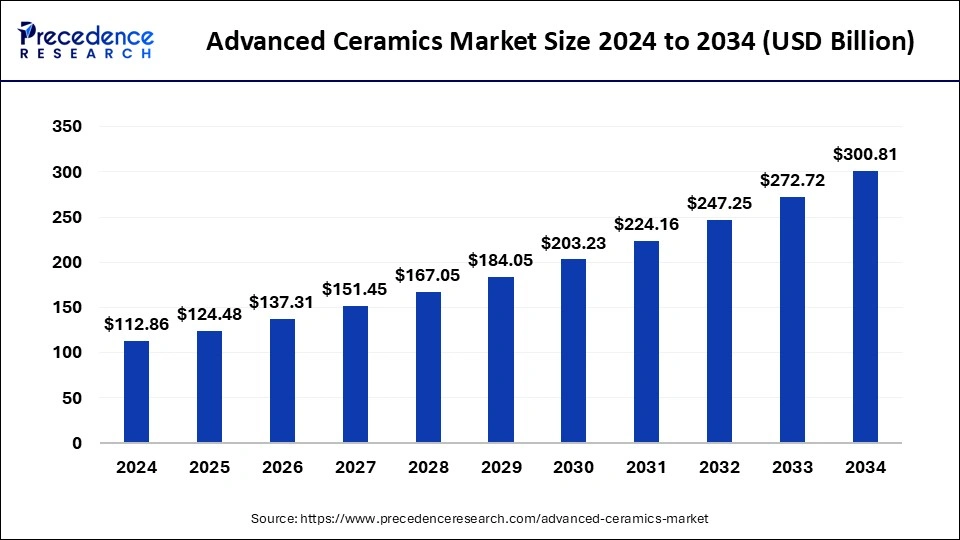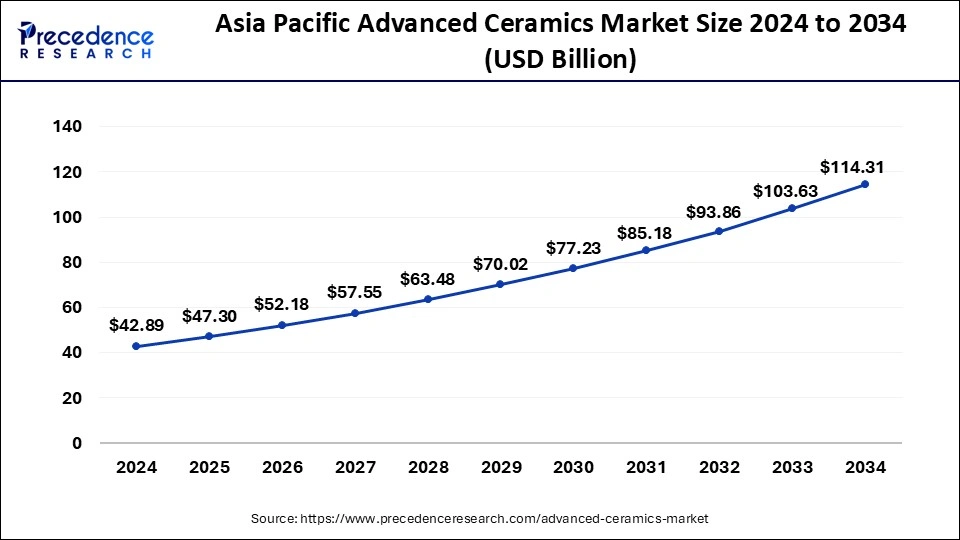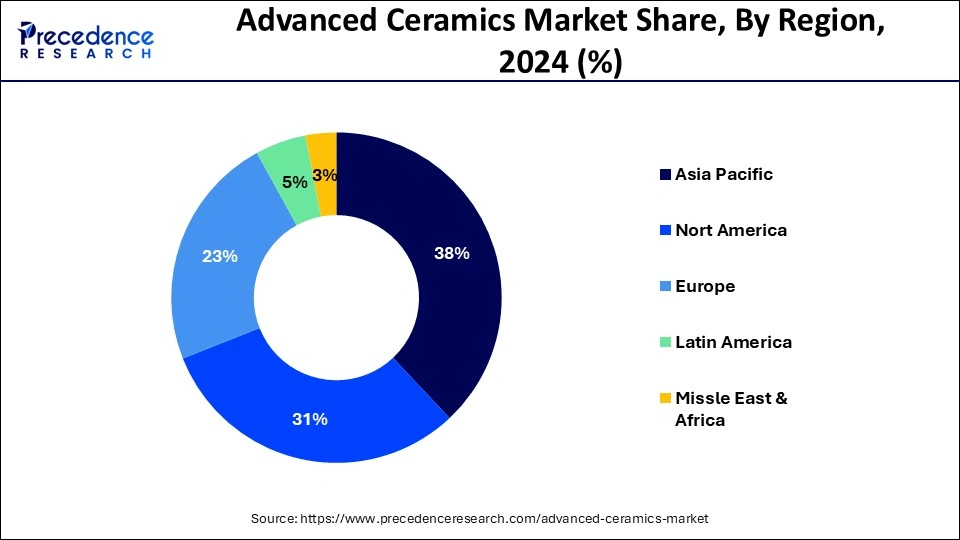List of Contents
What is Advanced Ceramics Market Size?
The global advanced ceramics market size is estimated at USD 124.48 billion in 2025 and is predicted to increase from USD 137.31 billion in 2026 to approximately USD 327.15 billion by 2035, expanding at a CAGR of 10.14% from 2026 to 2035

Market Highlights
- Asia Pacific led the global market with the highest market share of 38% in 2025.
- By product, the monolithics segment has held the largest market share in 2025.
- By material, the alumina segment captured the biggest revenue share in 2025.
- By application, the electronic devices segment registered the maximum market share in 2025.
Advanced Ceramics Market Growth Factors
Increasing demand of advanced ceramics from various industries that include electronics, heavy machinery, cutting tools, automotive, energy, and defense is a key factor that impels the growth of the market. Further, the growth of the industry is largely dependent on the dynamics of the electronic devices & electrical equipment that accounted for more than 70.0% of the total product demand in the year 2018. Products that are made from advanced ceramics for example electrical conductive elastomers are increasingly used in lamps, wire insulation, cell phones, lighting, power distribution, and inter-connectors because of their superior dielectric properties as well as good thermal stability.
Market Scope
| Report Highlights | Details |
| Market Size in 2025 | USD 124.48 Billion |
| Market Size in 2026 | USD 137.31 Billion |
| Market Size by 2035 | USD 327.15 Billion |
| Growth Rate from 2026 to 2035 | CAGR of 10.14% |
| Largest Market | Asia Pacific |
| Fastest Growing Market | North America |
| Base Year | 2025 |
| Forecast Period | 2026 to 2035 |
| Segments Covered | Product, Material, Application, End User,and Region |
| Regions Covered | North America, Asia Pacific, Europe, Latin America, Middle East and Africa |
Advanced Ceramics Market Segment Insights
Product Insights
The monolithics segment was examined as the largest revenue contributor in the year 2024 and accounted for nearly 80% of value share in that year. Increasing product utilization in the electronics & electrical sector, especially in the developing countries of the Asia Pacific expected to fuel its demand over the forthcoming years. Some of the major types of product aresilicon carbide zirconium, silicon nitride, and zirconium carbide. These materials possess favorable properties for industrial use such as wear, durability, reliability, and high-temperature resistance.
On the contrary, ceramic matrix composites estimated to be the fastest growing segment with a CAGR of around 11% over the analysis period. They are mostly preferred in applications such as mechanical, environment, chemical, aerospace, defense, and energy because of their superior properties that include high strength along with excellent heat &wear resistance. Further, the segment registers an extensive Research & Development (R&D) processes for the development of advanced products that acts as an effective alternative for the metal alloys in hot zone structures.
Material Insights
Based on material, alumina led the global advanced ceramics market in 2024, accounting for a value share of 35% that year. Alumina or aluminum oxide refers to an advanced engineering material that possesses excellent wear resistance property. Moreover, high-cost effectiveness of the material plays a significant role in its extensive application in numerous end-use industries.
Titanate segment projected to grow at a rapid pace over the upcoming years witnessing a CAGR of around 11.0%. Titanate or aluminum titanate has the most vibrant thermal shock resistance compared to other materials across the world. Hence, the components made using this material likely to withstand extremely high temperatures of around several hundred degrees. The U.S. is the most prominent region in this material segment and further its demand predicted to rise at a significant rate across the region. Besides this, the Asia Pacific also estimated to be a key region in this segment owing to its increasing demand from electrical and manufacturing sectors.
Application Insights
By application, electronic devices captured the largest value share in the advanced ceramics market in the year 2024 and accounted for nearly half of the global revenue that year. Increasing need for high-performance and cost-effective electronic gadgets, particularly in the Asia Pacific expected to fuel the growth of the segment over the analysis timeframe. Advanced ceramics are widely used in the electronic device for insulating, superconducting, semiconducting, magnetic, and piezoelectric applications.
Bioceramics are analyzed to show the fastest growth over the forecast timeframe. They are inert substances that possess tremendous strength and wear resistance. Henceforth, they are largely utilized in surgical implants for example dental and bone implants. Aluminum oxide and zirconia oxide are the commonly used materials in this segment.
Advanced Ceramics MarketRegional Insights
The Asia Pacific advanced ceramics market size is estimated at USD 47.30 billion in 2025 and is predicted to be worth around USD 124.38 billion by 2035, at a CAGR of 10.15% from 2026 to 2035.

The Asia Pacific emerged as the largest advanced ceramic market accounting for a value share of around 38% in 2024. Further, the region is expected to retain its position during the forthcoming years because of prominent growth in the automotive and electrical &electronics industries, especially in India and China. The region has been a prominent contributor in the electronics industry owing to the excellent demand of consumer electronic devices, particularly in the emerging countries such as India, China, and Thailand.
North America expected to register significant growth in the industry in the wake of increasing healthcare awareness along with the rising electronics industry in the region. Although the electronics industry in North America is relatively matured, the product demand for various electronic devices set to escalate due to rising penetration of smart homes and smart offices in the region.

Advanced Ceramics Market Companies
- Elan Technology
- CeramTec GmbH
- Oerlikon Surface Solutions AG
- Morgan Advanced Materials PLC
- Ortech Incorporated
- CoorsTek
- 3M Company
- Kyocera Industrial Ceramics Corporation
- Saint Gobain S.A.
- Murata Manufacturing Co. Ltd.
Advanced Ceramics MarketSegments Covered in the Report
By Product
- Ceramic Coatings
- Monolithic Ceramics
- Ceramic Matrix Composites
By Material
- Titanate
- Alumina
- Zirconate
- Aluminum Nitride
- Ferrite
- Silicon Nitride
- Silicon Carbide
By Application
- Catalyst Supports
- Electrical Equipment
- Bioceramics
- Electronic Devices
- Engine Parts
- Wear Parts
- Filters
- Others
By End-Use
- Automotive
- Electrical & Electronics
- Machinery
- Medical
- Environmental
- Others
By Region
- North America
- Asia Pacific
- Europe
- Latin America
- Middle East and Africa
For inquiries regarding discounts, bulk purchases, or customization requests, please contact us at sales@precedenceresearch.com
Frequently Asked Questions
Tags
Ask For Sample
No cookie-cutter, only authentic analysis – take the 1st step to become a Precedence Research client



